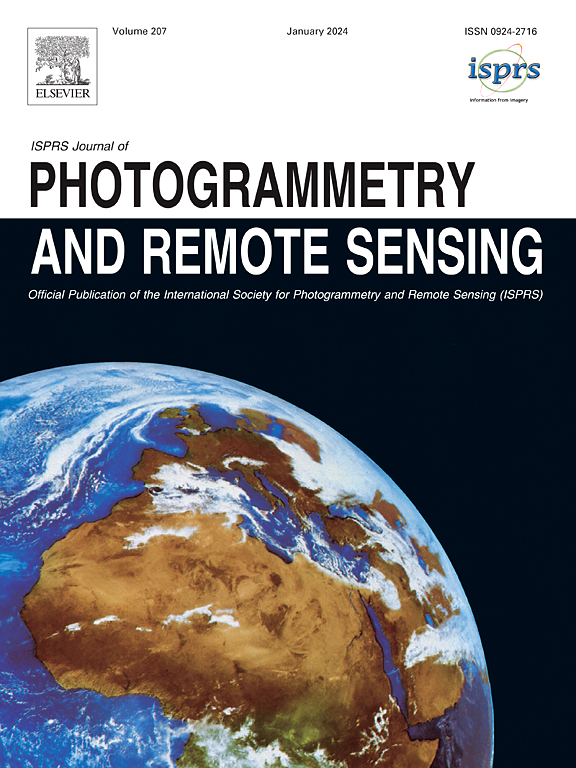Descriptor-based optical flow quality assessment and error model construction for visual localization
IF 10.6
1区 地球科学
Q1 GEOGRAPHY, PHYSICAL
ISPRS Journal of Photogrammetry and Remote Sensing
Pub Date : 2025-02-10
DOI:10.1016/j.isprsjprs.2025.01.019
引用次数: 0
Abstract
Precise matching of visual features between frames is crucial for the robustness and accuracy of visual odometry and SLAM (Simultaneous Localization and Mapping) systems. However, factors such as complex illumination and texture variations may cause significant errors in feature correspondences that will degrade the accuracy of visual localization. In this paper, we utilize the feature descriptor to validate and assess the correspondence quality of the optical flow algorithm, and establish the information matrix of visual measurements, which is used for improving the accuracy of visual localization in the nonlinear optimization framework. This proposed approach of optical flow quality assessment leverages the complementary advantages of the optical flow algorithm and descriptor matching, and it is applicable to other visual odometry or SLAM systems that use the optical flow algorithm for feature correspondence. We first demonstrate through simulation experiments the statistical correlation between optical flow error and descriptor Hamming distance. Subsequently, based on the statistical correlation, the optical flow tracking error is quantitatively estimated using the descriptor Hamming distance. As a result, features with large tracking errors are rejected as outliers, and other features are remained with an adequate error model, i.e. information matrix in the nonlinear optimization, which corresponds with the visual tracking error. Furthermore, rather than direct tracking error between the initial observation frame and the current frame, we proposed the cumulative tracking error for successive frames (CTE-SF) to improve the efficiency of descriptor extraction in successive visual tracking, as it requires no the construction of multi-scale image pyramids. We evaluated the proposed solution using the open datasets and our developed in-house embedded positioning device. The results indicate that the proposed solution can improve the accuracy of visual odometry systems utilizing the optical flow algorithm for feature correspondence (e.g., VINS-Mono) by approximately 10%–50%, while requiring only an 11% increase in computational resource consumption. We have made our implementation open-source, available at: https://github.com/Jett64/VINS-with-Error-Model.
基于描述符的光流质量评估及视觉定位误差模型构建
帧间视觉特征的精确匹配对于视觉里程计和SLAM (Simultaneous Localization and Mapping)系统的鲁棒性和准确性至关重要。然而,复杂的光照和纹理变化等因素可能会导致特征对应的显著误差,从而降低视觉定位的准确性。本文利用特征描述子对光流算法的对应质量进行验证和评估,建立视觉测量信息矩阵,用于提高非线性优化框架下视觉定位的精度。本文提出的光流质量评估方法利用了光流算法与描述子匹配的互补优势,适用于光流算法进行特征对应的其他视觉里程计或SLAM系统。首先通过仿真实验证明了光流误差与描述子汉明距离之间的统计相关性。然后,基于统计相关性,利用描述子汉明距离定量估计光流跟踪误差。因此,将跟踪误差较大的特征作为离群值拒绝,而保留其他特征,并在非线性优化中建立一个适当的误差模型,即与视觉跟踪误差相对应的信息矩阵。此外,我们提出了连续帧累积跟踪误差(CTE-SF),而不是初始观测帧与当前帧之间的直接跟踪误差,以提高连续视觉跟踪中描述符提取的效率,因为它不需要构建多尺度图像金字塔。我们使用开放数据集和我们开发的内部嵌入式定位设备评估了提出的解决方案。结果表明,该解决方案可以将利用光流算法进行特征对应的视觉里程计系统(例如vin - mono)的精度提高约10%-50%,同时只需要增加11%的计算资源消耗。我们已经使我们的实现开源,可在:https://github.com/Jett64/VINS-with-Error-Model。
本文章由计算机程序翻译,如有差异,请以英文原文为准。
求助全文
约1分钟内获得全文
求助全文
来源期刊

ISPRS Journal of Photogrammetry and Remote Sensing
工程技术-成像科学与照相技术
CiteScore
21.00
自引率
6.30%
发文量
273
审稿时长
40 days
期刊介绍:
The ISPRS Journal of Photogrammetry and Remote Sensing (P&RS) serves as the official journal of the International Society for Photogrammetry and Remote Sensing (ISPRS). It acts as a platform for scientists and professionals worldwide who are involved in various disciplines that utilize photogrammetry, remote sensing, spatial information systems, computer vision, and related fields. The journal aims to facilitate communication and dissemination of advancements in these disciplines, while also acting as a comprehensive source of reference and archive.
P&RS endeavors to publish high-quality, peer-reviewed research papers that are preferably original and have not been published before. These papers can cover scientific/research, technological development, or application/practical aspects. Additionally, the journal welcomes papers that are based on presentations from ISPRS meetings, as long as they are considered significant contributions to the aforementioned fields.
In particular, P&RS encourages the submission of papers that are of broad scientific interest, showcase innovative applications (especially in emerging fields), have an interdisciplinary focus, discuss topics that have received limited attention in P&RS or related journals, or explore new directions in scientific or professional realms. It is preferred that theoretical papers include practical applications, while papers focusing on systems and applications should include a theoretical background.
 求助内容:
求助内容: 应助结果提醒方式:
应助结果提醒方式:


